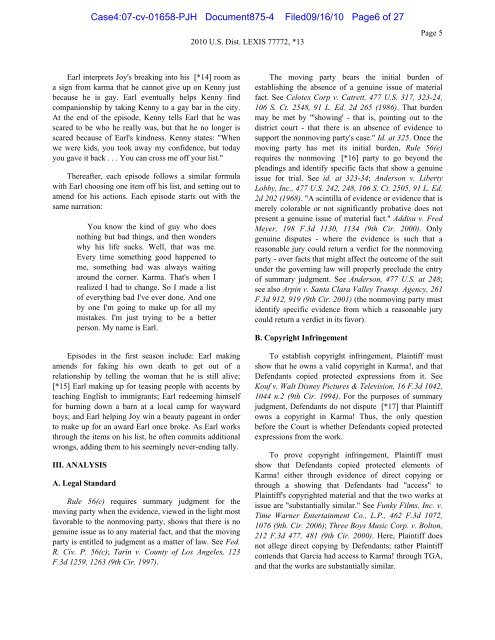exhibit 2 - SAP Lawsuit Portal
exhibit 2 - SAP Lawsuit Portal
exhibit 2 - SAP Lawsuit Portal
Create successful ePaper yourself
Turn your PDF publications into a flip-book with our unique Google optimized e-Paper software.
Earl interprets Joy's breaking into his [*14] room as<br />
a sign from karma that he cannot give up on Kenny just<br />
because he is gay. Earl eventually helps Kenny find<br />
companionship by taking Kenny to a gay bar in the city.<br />
At the end of the episode, Kenny tells Earl that he was<br />
scared to be who he really was, but that he no longer is<br />
scared because of Earl's kindness. Kenny states: "When<br />
we were kids, you took away my confidence, but today<br />
you gave it back . . . You can cross me off your list."<br />
Thereafter, each episode follows a similar formula<br />
with Earl choosing one item off his list, and setting out to<br />
amend for his actions. Each episode starts out with the<br />
same narration:<br />
You know the kind of guy who does<br />
nothing but bad things, and then wonders<br />
why his life sucks. Well, that was me.<br />
Every time something good happened to<br />
me, something bad was always waiting<br />
around the corner. Karma. That's when I<br />
realized I had to change. So I made a list<br />
of everything bad I've ever done. And one<br />
by one I'm going to make up for all my<br />
mistakes. I'm just trying to be a better<br />
person. My name is Earl.<br />
Episodes in the first season include: Earl making<br />
amends for faking his own death to get out of a<br />
relationship by telling the woman that he is still alive;<br />
[*15] Earl making up for teasing people with accents by<br />
teaching English to immigrants; Earl redeeming himself<br />
for burning down a barn at a local camp for wayward<br />
boys; and Earl helping Joy win a beauty pageant in order<br />
to make up for an award Earl once broke. As Earl works<br />
through the items on his list, he often commits additional<br />
wrongs, adding them to his seemingly never-ending tally.<br />
III. ANALYSIS<br />
A. Legal Standard<br />
Case4:07-cv-01658-PJH Document875-4 Filed09/16/10 Page6 of 27<br />
Rule 56(c) requires summary judgment for the<br />
moving party when the evidence, viewed in the light most<br />
favorable to the nonmoving party, shows that there is no<br />
genuine issue as to any material fact, and that the moving<br />
party is entitled to judgment as a matter of law. See Fed.<br />
R. Civ. P. 56(c); Tarin v. County of Los Angeles, 123<br />
F.3d 1259, 1263 (9th Cir. 1997).<br />
2010 U.S. Dist. LEXIS 77772, *13<br />
The moving party bears the initial burden of<br />
establishing the absence of a genuine issue of material<br />
fact. See Celotex Corp v. Catrett, 477 U.S. 317, 323-24,<br />
106 S. Ct. 2548, 91 L. Ed. 2d 265 (1986). That burden<br />
may be met by "'showing' - that is, pointing out to the<br />
district court - that there is an absence of evidence to<br />
support the nonmoving party's case." Id. at 325. Once the<br />
moving party has met its initial burden, Rule 56(e)<br />
requires the nonmoving [*16] party to go beyond the<br />
pleadings and identify specific facts that show a genuine<br />
issue for trial. See id. at 323-34; Anderson v. Liberty<br />
Lobby, Inc., 477 U.S. 242, 248, 106 S. Ct. 2505, 91 L. Ed.<br />
2d 202 (1968). "A scintilla of evidence or evidence that is<br />
merely colorable or not significantly probative does not<br />
present a genuine issue of material fact." Addisu v. Fred<br />
Meyer, 198 F.3d 1130, 1134 (9th Cir. 2000). Only<br />
genuine disputes - where the evidence is such that a<br />
reasonable jury could return a verdict for the nonmoving<br />
party - over facts that might affect the outcome of the suit<br />
under the governing law will properly preclude the entry<br />
of summary judgment. See Anderson, 477 U.S. at 248;<br />
see also Arpin v. Santa Clara Valley Transp. Agency, 261<br />
F.3d 912, 919 (9th Cir. 2001) (the nonmoving party must<br />
identify specific evidence from which a reasonable jury<br />
could return a verdict in its favor).<br />
B. Copyright Infringement<br />
Page 5<br />
To establish copyright infringement, Plaintiff must<br />
show that he owns a valid copyright in Karma!, and that<br />
Defendants copied protected expressions from it. See<br />
Kouf v. Walt Disney Pictures & Television, 16 F.3d 1042,<br />
1044 n.2 (9th Cir. 1994). For the purposes of summary<br />
judgment, Defendants do not dispute [*17] that Plaintiff<br />
owns a copyright in Karma! Thus, the only question<br />
before the Court is whether Defendants copied protected<br />
expressions from the work.<br />
To prove copyright infringement, Plaintiff must<br />
show that Defendants copied protected elements of<br />
Karma! either through evidence of direct copying or<br />
through a showing that Defendants had "access" to<br />
Plaintiff's copyrighted material and that the two works at<br />
issue are "substantially similar." See Funky Films, Inc. v.<br />
Time Warner Entertainment Co., L.P., 462 F.3d 1072,<br />
1076 (9th. Cir. 2006); Three Boys Music Corp. v. Bolton,<br />
212 F.3d 477, 481 (9th Cir. 2000). Here, Plaintiff does<br />
not allege direct copying by Defendants; rather Plaintiff<br />
contends that Garcia had access to Karma! through TGA,<br />
and that the works are substantially similar.


